-
PDF
- Split View
-
Views
-
Cite
Cite
Daniel F. Ortega, M. Victoria Sammartino, Graciela M.M. Pellegrino, Luis D. Barja, Gaston Albina, Eliseo V. Segura, Roberto Balado, Ruben Laiño, Alberto G. Giniger, Runaway pacemaker: A forgotten phenomenon?, EP Europace, Volume 7, Issue 6, 2005, Pages 592–597, https://doi.org/10.1016/j.eupc.2005.06.004
Close - Share Icon Share
Abstract
Runaway is an uncommon pacemaker dysfunction, characterized by fast and erratic spikes at non-physiological rates.
This infrequent but potentially lethal failure mode may be related to low battery voltage.
Four single chamber pacemaker patients were analyzed (Medtronic Minix ST 8330, Minneapolis, MN, had been implanted in two patients and two CPI Triumph VR 1124, St Paul, MN, in the other two). They had been admitted because of presyncopal episodes. Typical high rate stimuli at 2000 ppm alternating with pacing at 60–65 ppm were recorded in all ECGs. Lead system tests were normal. The pulse generators had to be replaced.
Introduction
Pacemaker patient follow-up is recommended to be more frequent near replacement time to avoid generator failure due to low or depleted battery voltage.
Runaway is a rare but dangerous phenomenon due to generator dysfunction which may be related to its late replacement and battery depletion.
Low battery voltage can provoke low rate stimuli, capture and sensing failures, mode changes and less frequently the runaway phenomenon.
This event shows a typical ECG with captured beats alternating with non-captured high rate spikes. Fortunately, in these cases the patients displayed spontaneous rhythm.
Runaway could have been avoided by timely pacemaker replacement[1].
Case 1
A Medtronic model Minix ST 8330 (Minneapolis, MN) was implanted in a 67-year-old patient in another institution in 1994 because of complete atrioventricular (AV) block, with no recent follow-up.
He was admitted to our Intensive Care Unit because of presyncopal episodes for 3 days.
He was alert, with an average heart rate of 40 bpm, and his blood pressure was 130/80 mmHg.
The ECG showed a pacemaker rhythm at 60 ppm in VOO mode interrupted by repeated spike bursts at 2000 ppm of 3 s duration and progressively decreasing amplitude.
During bursts, atrial flutter was observed with an escape ventricular rhythm at 30 bpm.
Low blood pressure was observed during runaway episodes (Fig. 1).
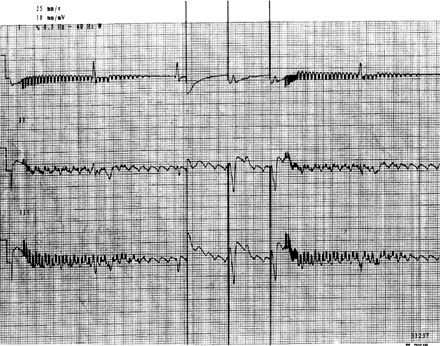
Medtronic Minix ST 8330 patient ECG record. Starting with a pacing burst at approximately 2000 ppm for about 3 s with decreasing amplitude and rate. Patient's own rhythm, atrial flutter, with ventricular escape rhythm at 30 bpm. In the middle, three spikes are seen at 60 ppm in VOO mode, the first in ventricular refractory. Later, re-initiation of the phenomenon is shown.
Magnet manoeuvres did not provoke any change.
The generator was interrogated by telemetry (Fig. 2) and showed VOO mode programmed at 70 ppm. Battery depletion was detected: 1.83 V, an extremely low level, well below elective replacement level[2,,3]. A Medtronic model Thera SR 8942 (Minneapolis, MN) was implanted to replace the exhausted device. The lead system was retained because threshold and resistance values were in acceptable ranges.
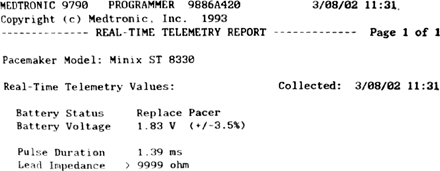
Real time telemetry. Battery depletion detected at 1.83 V. Extremely low battery voltage.
Case 2
A VVIR, CPI model Triumph 1124 (St Paul, MN), was implanted in a 78-year-old patient in another institution in 1994 because of complete AV block, programmed at a low rate of 60 ppm.
This patient was admitted to our Intensive Care Unit because of presyncopal episodes, normotensive with an average heart rate of 40 bpm.
The ECG showed 2000 ppm spikes with decreasing amplitude without any ventricular capture, and an escape rhythm recorded at 40 bpm followed by isolated captured beats at 60 ppm (Fig. 3).
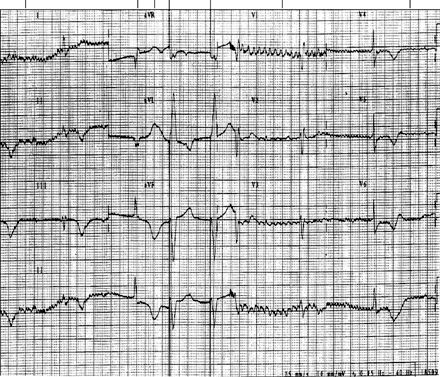
Triumph VR 1124 CPI pacemaker patient ECG recording. Spike burst at approximately 2000 ppm with decreasing amplitude and frequency. The underlying rhythm is complete AV block with escape beats at 40 bpm. Captured beats at 60 ppm are observed in the middle of the strip. Re-initiation of the phenomenon is shown.
Magnetic manoeuvres did not provoke any change.
Telemetric reports were not obtained due to lack of telemetric communication. The patient had not attended follow-up for 2 years.
Case 3
This case was referred by another institution and was admitted to the Intensive Care Unit because of syncopal episodes and stroke. A Medtronic ST 8330 pacemaker (Minneapolis, MN) had been implanted 8 years earlier because of complete AV block.
A typical high rate spike ECG alternating with captured beats at 60 ppm was recorded (Fig. 4).
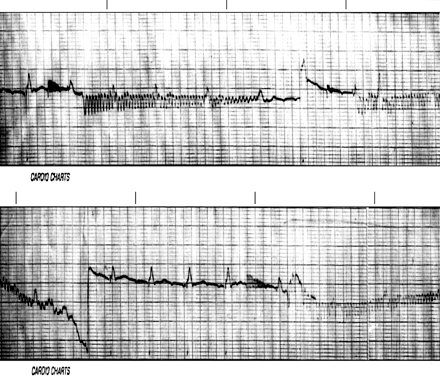
Medtronic Minix ST 8330 pacemaker patient runaway phenomenon. Continuous strip: at the top, some captured beats may be observed alternating with rapid, non-captured beats of irregular stimuli at 2000 ppm. During this episode the patient's spontaneous rhythm is shown. The sequence is randomly repeated.
Only the pacemaker was replaced as threshold and resistance of the ventricular lead were normal.
Case 4
A 55-year-old woman with a history of aortic valve replacement 24 years earlier, due to severe aortic stenosis, required a VVIR pacemaker because of complete AV block.
She had undergone five generator replacements due to depleted battery, the last in 1996.
She was admitted to our institution for dizziness, presyncopal episodes, and fatigue. Her ECG (Fig. 5) showed a typical runaway phenomenon. The pacemaker was replaced by a Medtronic VVI. During her hospital stay, she presented a “Torsade de Pointes” episode that was successfully defibrillated (Fig. 6).
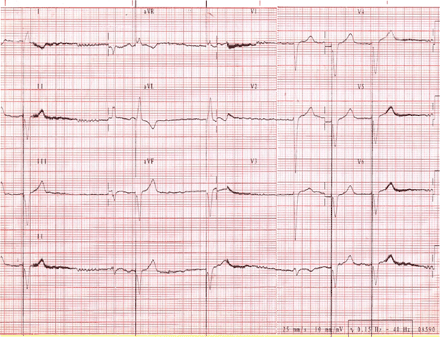
ECG showing pacemaker rhythm alternating with the patient's own rhythm with different intervals. After the first beat, a typical runaway phenomenon is observed with a 2100 ms pause and a subsidiary escape rhythm. The following paced beat is delivered without correct sensing. The last two paced beats have an interval of 1000 ms.
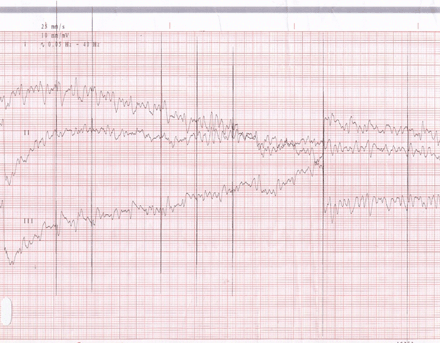
ECG shows a storm of ventricular fibrillation. Spikes with different intervals. Previously the patient presented ventricular tachycardia (torsade de pointes) and had to be defibrillated.
Discussion
A typical runaway ECG (Fig. 1, 3–35) shows intermittent ventricular capture at a rate slower than normal, numerous spikes at a very high rate with different voltages and often without capture beats, simulating an ECG artifact.
Capture beat rate is low because this phenomenon occurs at the end of pacemaker life with depleted battery voltage.
High rate spikes fail to capture because of low amplitude and due to the fact that at such very high rates the ventricle is refractory to many stimuli.
Two clinical aspects were important:
The patients survived because they were not pacemaker-dependent.
Runaway did not provoke any potentially lethal arrhythmias. The “torsade de pointes” episode in one patient was related to bradyarrhythmia and not due to overstimulation.
This phenomenon is observed when elective replacement is overdue and the battery had low voltage, well below the safety margin[4–,6].
The runaway phenomenon was first described in external and internal pacemakers in 1970 and it is one of the causes of sudden death due to pacemaker failure[1]. Interestingly, these findings had already been attributed to an electric circuit failure, early in pacemaker implantation in Argentina[7,,8].
However, in the last decade only isolated cases have been published [9,,10].
The most frequent causes of runaway are associated with:
Sudden failure in one of the pacemaker circuits[3].
Battery depletion.
Circuit destruction or deterioration due to electric diathermy or therapeutic radiation[5].
Runaway was also described in implantable cardioverter defibrillator patients due to crystal oscillator failure[2].
Today, pacemakers and defibrillators have security designed to prevent runaway: the presence of a maximum rate, hermetic sealing, and a decrease in pulse amplitude at high rates with concomitant loss of capture. Despite these measures, correct performance of the pacemaker below the security battery voltage is not guaranteed[5].
Even though the potential runaway hazard is induction of ventricular fibrillation or other ventricular arrhythmias, loss of capture and bradyarrhythmias or asystole in pacemaker-dependent patients must also be considered.
The patients in this report did not have frequent follow-up visits after implantation. In fact, it was impossible to determine the presumed replacement period.
Patients were almost asymptomatic at rest so no active measure was taken at day 1. Pacemakers were replaced on the day after admission. The most appropriate behaviour should have been urgent pacemaker removal because, as mentioned earlier, during runaway periods ventricular arrhythmias might occur. Furthermore, intermittent capture could induce subsidiary foci suppression by overdrive pacing and the bradycardia in the complete heart block can provoke “torsade de pointes”.
This potentially lethal phenomenon can be avoided by having appropriate follow-up. We presume that there might have been other cases which were not identified because their first episode was lethal.
Conclusions
The runaway phenomenon is associated with very low battery voltage together with late pacemaker replacement.
It is a potentially lethal clinical entity.
Few reports do not mean an absence of this phenomenon.
Appropriate follow-up programmes will prevent future pacemaker failures.



